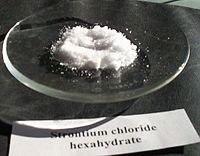| Revision as of 09:41, 16 December 2005 editPhyschim62 (talk | contribs)Autopatrolled, Extended confirmed users, Pending changes reviewers33,631 edits →Uses: more uses from de:Strontiumchlorid← Previous edit | Revision as of 10:34, 17 January 2006 edit undo81.108.62.192 (talk) →PreparationNext edit → | ||
| Line 85: | Line 85: | ||
| Strontium chloride can be prepared from ] or ] reacting with ]: | Strontium chloride can be prepared from ] or ] reacting with ]: | ||
| ](]) + 2 ](]) → SrCl<sub>2</sub>(]) + 2 ](]) | ](]) + 2 ](]) → SrCl<sub>2</sub>(]) + 2 ](]) | ||
| It can also be prepared by the union of the elements, ] and ]. | It can also be prepared by the union of the elements, ] and ]. | ||
Revision as of 10:34, 17 January 2006
 Strontium chloride hexahydrate | |
| IUPAC name Strontium chloride | |
| General | |
|---|---|
| Molecular formula | SrCl2 |
| Molecular weight | 158.53 amu (anhydrous)
266.62 amu (hexahydrate) |
| Appearance | White crystalline solid |
| CAS number | (anhydrous)
(hexahydrate) |
| MSDS | Strontium chloride MSDS |
| Other names | |
| |
| Bulk properties | |
| Density | 3.052 g/cm (anhydrous, monoclinic form) |
| Solubility | water: 53.8 g/100 cm (20 °C)
ethanol: very slightly soluble acetone: very slightly soluble |
| Melting point | 874 °C (1147 K) |
| Boiling point | 1250 °C (1520 K) |
| Hazards: | Irritant |
| Structure | |
| Coordination geometry | octahedral (six-coordinate) |
| Crystal structure | Deformed TiO2 |
| Hydrates | dihydrate (rare)
hexahydrate |
| Related compounds | |
| strontium fluoride | calcium chloride |
Strontium chloride (SrCl2) is a salt of strontium and chlorine. It is ionic and water-soluble. It is less toxic than barium chloride, though more toxic than calcium chloride. It emits a bright red colour when heated in a flame.
Chemical Properties
Strontium chloride is a typical ionic metal salt, and it can be used as a source of other strontium compounds such as strontium chromate:
SrCl2(aq) + Na2CrO4(aq) → SrCrO4(s) + 2 NaCl(aq)
SrCl2 always acts as a simple salt, and it is completely neutral in solution.
Preparation
Strontium chloride can be prepared from strontium hydroxide or strontium carbonate reacting with hydrochloric acid:
Sr(OH)2(aq) + 2 HCl(aq) → SrCl2(aq) + 2 H2O(l)
It can also be prepared by the union of the elements, strontium and chlorine.
Uses
There are no major uses for strontium chloride, though it can be used to prepare less common compounds of strontium. Like barium chloride it can be used to test for sulfate ion, though not at such low concentration, since strontium sulfate is more soluble than barium sulfate.
SrCl2(aq) + SO4(aq) → SrSO4(s) + 2 Cl(aq)
Strontium chloride is occasionally used as a flame coloring agent (red) in pyrotechnics, and in small quantities in glass making and metallurgy. It is added to some toothpastes to reduce periodontal disease, and is used in homeopathic medicine under the name of strontium chlorii.
The radioactive isotope strontium-89 is usually administered in the form of strontium chloride: it is used for the treatment of bone cancer.
Sea water aquaria must add small amounts of strontium chloride to the water, as it is consumed in the production of the exoskeletons of certain plankton.
Precautions
Although much less toxic than barium chloride, strontium chloride should still be handled with care.
Suppliers/Manufacturers
References
- N. N. Greenwood, A. Earnshaw, Chemistry of the Elements, Pergamon Press, Oxford, UK, 1984
- Handbook of Chemistry and Physics, 71st edition, CRC Press, Ann Arbor, Michigan, 1990
- The Merck Index, 7th edition, Merck & Co., Rahway, New Jersey, 1960